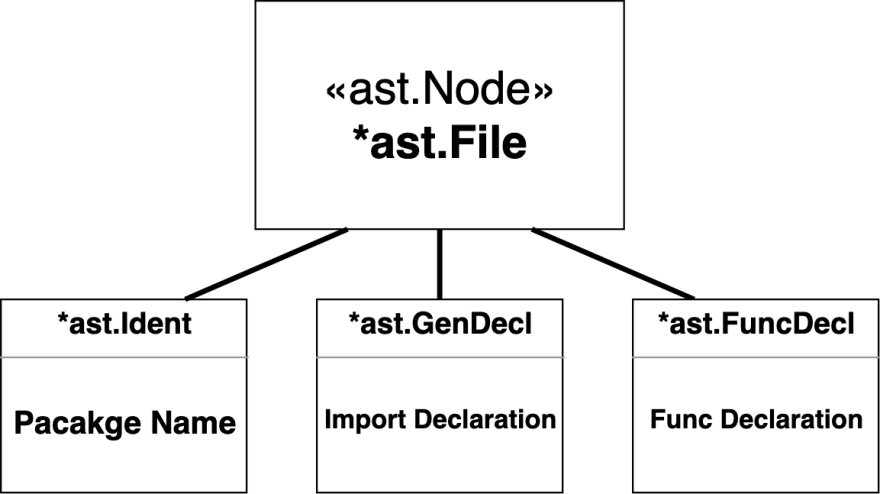This article is originally posted here.
What do you refer to when you're curious about the Go AST? A document? Source code?
While reading the documentation helps you understand it in the abstract, you can't see how APIs relate to each other, etc.
Not to mention, read the entire source code and you'll see it completely, but you should get tired from trying to read the whole stuff.
Therefore, this article aims to be in the middle of them. Let's take it easy and take a walk through AST to understand how the Go code we usually write is represented internally.
It doesn't delve into how to parse the source code, and starts with the description after the AST is built.
If you're curious about how the code is converted to the AST, navigate to Digging deeper into the analysis of Go-code.
Let’s get started!
Interfaces
First up, let me briefly describe the interface that represents each of the AST nodes.
All AST nodes implement the ast.Node interface, which just returns a position in the AST.
In addtion, there are 3 main interfaces that implement ast.Node:
- ast.Expr — representing expressions and types node
- ast.Stmt — representing statement node
- ast.Decl — representing declaration node
You can see from the definition that every Node satisfies the ast.Node interface:
// All node types implement the Node interface.
type Node interface {
Pos() token.Pos // position of first character belonging to the node
End() token.Pos // position of first character immediately after the node
}
// All expression nodes implement the Expr interface.
type Expr interface {
Node
exprNode()
}
// All statement nodes implement the Stmt interface.
type Stmt interface {
Node
stmtNode()
}
// All declaration nodes implement the Decl interface.
type Decl interface {
Node
declNode()
}
Getting started with walking
Let's start walking! Take a look at the file we convert to the AST:
package hello
import "fmt"
func greet() {
fmt.Println("Hello, World")
}
Nothing fancy — an overly simple Hello, World program. The AST built on this is:
ast.File
*ast.File {
. Package: dummy.go:1:1
. Name: *ast.Ident {
. . NamePos: dummy.go:1:9
. . Name: "hello"
. }
. Decls: []ast.Decl (len = 2) {
. . 0: *ast.GenDecl {
. . . TokPos: dummy.go:3:1
. . . Tok: import
. . . Lparen: -
. . . Specs: []ast.Spec (len = 1) {
. . . . 0: *ast.ImportSpec {
. . . . . Path: *ast.BasicLit {
. . . . . . ValuePos: dummy.go:3:8
. . . . . . Kind: STRING
. . . . . . Value: "\"fmt\""
. . . . . }
. . . . . EndPos: -
. . . . }
. . . }
. . . Rparen: -
. . }
. . 1: *ast.FuncDecl {
. . . Name: *ast.Ident {
. . . . NamePos: dummy.go:5:6
. . . . Name: "greet"
. . . . Obj: *ast.Object {
. . . . . Kind: func
. . . . . Name: "greet"
. . . . . Decl: *(obj @ 23)
. . . . }
. . . }
. . . Type: *ast.FuncType {
. . . . Func: dummy.go:5:1
. . . . Params: *ast.FieldList {
. . . . . Opening: dummy.go:5:11
. . . . . Closing: dummy.go:5:12
. . . . }
. . . }
. . . Body: *ast.BlockStmt {
. . . . Lbrace: dummy.go:5:14
. . . . List: []ast.Stmt (len = 1) {
. . . . . 0: *ast.ExprStmt {
. . . . . . X: *ast.CallExpr {
. . . . . . . Fun: *ast.SelectorExpr {
. . . . . . . . X: *ast.Ident {
. . . . . . . . . NamePos: dummy.go:6:2
. . . . . . . . . Name: "fmt"
. . . . . . . . }
. . . . . . . . Sel: *ast.Ident {
. . . . . . . . . NamePos: dummy.go:6:6
. . . . . . . . . Name: "Println"
. . . . . . . . }
. . . . . . . }
. . . . . . . Lparen: dummy.go:6:13
. . . . . . . Args: []ast.Expr (len = 1) {
. . . . . . . . 0: *ast.BasicLit {
. . . . . . . . . ValuePos: dummy.go:6:14
. . . . . . . . . Kind: STRING
. . . . . . . . . Value: "\"Hello, World\""
. . . . . . . . }
. . . . . . . }
. . . . . . . Ellipsis: -
. . . . . . . Rparen: dummy.go:6:28
. . . . . . }
. . . . . }
. . . . }
. . . . Rbrace: dummy.go:7:1
. . . }
. . }
. }
. Scope: *ast.Scope {
. . Objects: map[string]*ast.Object (len = 1) {
. . . "greet": *(obj @ 27)
. . }
. }
. Imports: []*ast.ImportSpec (len = 1) {
. . 0: *(obj @ 12)
. }
. Unresolved: []*ast.Ident (len = 1) {
. . 0: *(obj @ 46)
. }
}
How to walk
All we have to do is traverse this AST node in depth-first order.
Let's print each Node one by one by calling ast.Inspect() recursively.
Also, printing AST directly then we will typically see stuff that is not human readable.
To prevent that from happening, we're going to use ast.Print, a powerful API for human reading of AST:
package main
import (
"fmt"
"go/ast"
"go/parser"
"go/token"
)
func main() {
fset := token.NewFileSet()
f, _ := parser.ParseFile(fset, "dummy.go", src, parser.ParseComments)
ast.Inspect(f, func(n ast.Node) bool {
// Called recursively.
ast.Print(fset, n)
return true
})
}
var src = `package hello
import "fmt"
func greet() {
fmt.Println("Hello, World")
}
`
ast.File
The first Node to visit is *ast.File, which is the root of all AST nodes.
It implements only the ast.Node interface.
ast.File has references to a package name, import declarations, and function declarations as child nodes.
To be precise, it has also Comments and so on, but let me omit them for simplicity.
Let's start with Package Name.
(Note that fields with a nil value are omitted. See the document for a complete list of fields for each node type.)
Package Name
ast.Ident
*ast.Ident {
. NamePos: dummy.go:1:9
. Name: "hello"
}
A package name can be represented by the AST node type *ast.Ident, which implements the ast.Expr interface.
All identifiers are represented by this structure. It mainly contains its name and a source position within a file set.
From the code shown above, we can see that the package name is hello and is declared in the first line of dummy.go.
We can't dive any deeper into this node, let's go back to the *ast.File.
Import Declarations
ast.GenDecl
*ast.GenDecl {
. TokPos: dummy.go:3:1
. Tok: import
. Lparen: -
. Specs: []ast.Spec (len = 1) {
. . 0: *ast.ImportSpec {/* Omission */}
. }
. Rparen: -
}
A declaration of import is represented by the AST node type *ast.GenDecl, which implements the ast.Decl interface.
ast.GenDecl represents all declarations except for functions; That is, import, const, var, and type.
Tok represents a lexical token — which is specifies what the declaration is about (IMPORT or CONST or TYPE or VAR).
This AST Node tells us that the import declaration is on line 3 in dummy.go.
Let's visit ast.GenDecl in depth-first order. Take a look *ast.ImportSpec, the next Node.
ast.ImportSpec
*ast.ImportSpec {
. Path: *ast.BasicLit {/* Omission */}
. EndPos: -
}
An ast.ImportSpec node corresponds to a single import declaration.
It implements the ast.Spec interface.
Visiting Path could make more sense about the import path. Let's go there.
ast.BasicLit
*ast.BasicLit {
. ValuePos: dummy.go:3:8
. Kind: STRING
. Value: "\"fmt\""
}
An ast.BasicLit node represents a literal of basic type.
It implements the ast.Expr interface.
This contains a type of token and token.INT, token.FLOAT, token.IMAG, token.CHAR, or token.STRING can be used.
From ast.ImportSpec and ast.BasicLit, we can see it has imported package called "fmt".
We can't dive any deeper, let's get back to the top level again.
Function Declarations
ast.FuncDecl
*ast.FuncDecl {
. Name: *ast.Ident {/* Omission */}
. Type: *ast.FuncType {/* Omission */}
. Body: *ast.BlockStmt {/* Omission */}
}
An ast.FuncDecl node represents a function declaration.
It implements only the ast.Node interface.
Let's take a look at them in order from Name, representing a function name.
ast.Ident
*ast.Ident {
. NamePos: dummy.go:5:6
. Name: "greet"
. Obj: *ast.Object {
. . Kind: func
. . Name: "greet"
. . Decl: *(obj @ 0)
. }
}
The second time this has appeared, let me skip the basic explanation.
Noteworthy is the *ast.Object.
It represents the object to which the identifier refers, but why is this needed?
As you know, Go has a concept of scope, which is the extent of source text in which the identifier denotes the specified constant, type, variable, function, label, or package.
The Decl field indicates where the identifier was declared so that it identifies the scope of the identifier.
Identifiers that point to the identical object share the identical *ast.Object.
ast.FuncType
*ast.FuncType {
. Func: dummy.go:5:1
. Params: *ast.FieldList {/* Omission */}
}
Go back to being a parent one generation older, an ast.FuncType contains a function signature including parameters, results, and position of "func" keyword.
ast.FieldList
*ast.FieldList {
. Opening: dummy.go:5:11
. List: nil
. Closing: dummy.go:5:12
}
An ast.FieldList node represents a list of Fields, enclosed by parentheses or braces.
Function parameters would be shown here if they are defined, but this time none, so no information.
List field is a slice of *ast.Field that contains a pair of identifiers and types.
It is highly versatile and is used for a variety of Nodes, including *ast.StructType, *ast.InterfaceType, and here.
That is, it's needed when mapping a type to an identifier as shown below:
foo int
bar string
Let's loop back to *ast.FuncDecl again and dive a bit into Body, the last field.
ast.BlockStmt
*ast.BlockStmt {
. Lbrace: dummy.go:5:14
. List: []ast.Stmt (len = 1) {
. . 0: *ast.ExprStmt {/* Omission */}
. }
. Rbrace: dummy.go:7:1
}
An ast.BlockStmt node represents a braced statement list.
It implements the ast.Stmt interface.
It does have a list of statements. What an imaginable node!
ast.ExprStmt
*ast.ExprStmt {
. X: *ast.CallExpr {/* Omission */}
}
ast.ExprStmt represents an expression in a statement list.
It implements the ast.Stmt interface and contains a single ast.Expr.
ast.CallExpr
*ast.CallExpr {
. Fun: *ast.SelectorExpr {/* Omission */}
. Lparen: dummy.go:6:13
. Args: []ast.Expr (len = 1) {
. . 0: *ast.BasicLit {/* Omission */}
. }
. Ellipsis: -
. Rparen: dummy.go:6:28
}
ast.CallExpr represents an expression that calls a function.
The fields to look at are Fun, the function to call and Args, the list of arguments to pass to it.
ast.SelectorExpr
*ast.SelectorExpr {
. X: *ast.Ident {
. . NamePos: dummy.go:6:2
. . Name: "fmt"
. }
. Sel: *ast.Ident {
. . NamePos: dummy.go:6:6
. . Name: "Println"
. }
}
ast.SelectorExpr represents an expression followed by a selector.
Simply put, it means fmt.Println.
ast.BasicLit
*ast.BasicLit {
. ValuePos: dummy.go:6:14
. Kind: STRING
. Value: "\"Hello, World\""
}
No longer needed an explanation, Hello, World!
Bottom Line
I've left out some of the fields in the node types I've introduced, and there are still many other node types.
Nevertheless, I'd say it's significant to actually walk the walk even if it's a bit rough. And above all, it’s quite a bit of fun.
Copy and paste the code shown in the section "How to walk", and have a try to walk around on your PC.








Top comments (0)